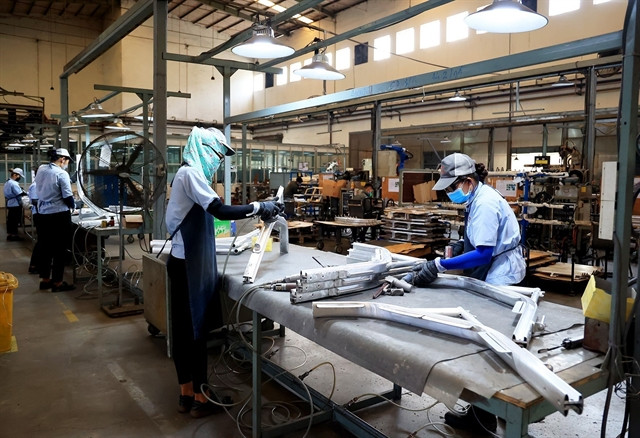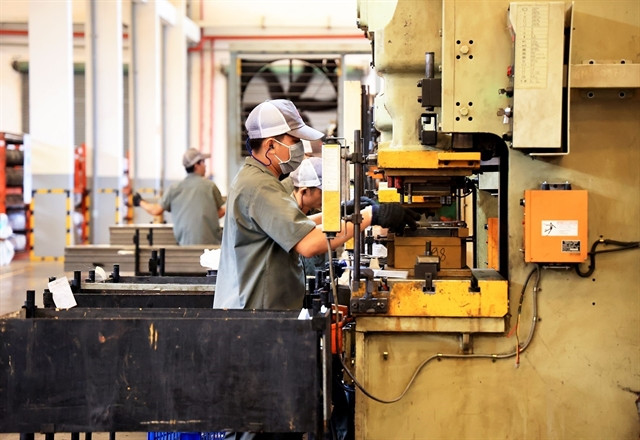 |
| Workers at Toàn Cầu Mechanical Factory in Giang Điền Industrial Zone, Trảng Bom, Đồng Nai. — VNA/VNS Photos Hồng Đạt |
The Vietnam News Agency reporters went to HCM City and the Southeast Region of Việt Nam to discover the challenges of the labour market in these regions and gather recommendations from experts to solve the underlying problems and create a better working environment.
Unstable labour market
After enduring the effects of the pandemic for two years, employment opportunities in the region have become unstable, with many workers experiencing abrupt reductions in work hours, temporary suspensions, or job loss in the late months of 2022 and early months of 2023 due to a lack of customer orders and capital to maintain operations.
Though it's a situation that nobody wants to be in, the unpredictable developments in life, such as the pandemic and the market, have made it increasingly difficult for workers to find and maintain employment.
V. T. Thoa, an employee of PouYuen Vietnam Co. Ltd., in Bình Chánh District, HCM City, has been searching for a new job since her contract was terminated.
She has not, however, found a new employer.
"Caring for my family is becoming increasingly challenging, but fortunately, our children are intelligent and diligent," said Thoa. "I am grateful that the authorities frequently assist families like ours."
Another employee, L.M. Ngọc, currently working at the Tỷ Hùng Co. Ltd., in Bình Tân District, HCM City, was disheartened when she lost her employment due to the company's dearth of orders and the need to scale back production and operations.
Like many of her coworkers still employed at the company, Ngọc was concerned when she realised there were no longer any job opportunities and it would be difficult to avoid unemployment. She is genuinely concerned about the future and unsure what to do or where to go.
After two years of the COVID-19 pandemic, although the difficulties seemed to be surmounted, everything for businesses and employees is truly unpredictable and challenging, particularly for export-dependent industries.
When businesses reduce working hours, income, and job stability, many families of out-of-town employees have sent their children back to their hometowns to live with their grandparents, and even spouses have returned to their hometowns one by one.
According to Củ Phát Nghiệp, Trade Union Chairman of PouYuen Vietnam Co. Ltd., which has more than 50,000 employees at times, when the pandemic broke out, thousands of workers were worried about their livelihoods in the city and the unpredictability of the pandemic, so they rushed back to their hometowns.
"After the pandemic was controlled, the company accelerated its recruitment efforts to fulfil the work that had been delayed during the pandemic," said Nghiệp. "However, recruiting new workers has been temporarily halted, and many employees have been laid off."
HCM City and other provinces and cities, notably industrial zones in the region, are experiencing significant job losses and reduced working hours.
In Q1 2023, more than 294,000 workers in Việt Nam were either jobless or had their hours cut, a decrease of 2,000 from Q4 2022, with foreign-invested businesses accounting for 83.8 per cent.
The number of workers on leave or reduced hours was 21,800 in Tây Ninh, 36,400 in Bình Dương, 35,000 in Đồng Nai and 19,800 in HCM City.
Việt Nam lost 149,000 enterprise jobs in the first quarter of 2023, compared to 118,000 in Q4 2022.
According to Phạm Chí Tâm, Vice Chairman of the HCM City Labour Confederation, the body has instructed firms' trade unions to regularly connect with workers and businesses to find solutions to overcome difficulties and build a cooperative worker-business relationship.
Nguyễn Văn Lâm, Deputy Director of the HCM City's Department of Labour, War Invalids, and Social Affairs, added that the city is implementing labour relations, social insurance, and unemployment insurance policies to help workers cover salary costs and stabilise their lives after losing their jobs.
Job introduction centres and vocational schools are improving their support, counselling, skills training, new job opportunities, resources, and loans to help workers with employment issues.
The HCM City People's Committee also supports workers in the informal sector access to loans from the National Employment Fund, the Fund for Poverty Reduction and Hunger Eradication, and the Capital Aid for Employment of the Poor Microfinance Institution (CEP) to switch jobs and create their own.
 |
| A worker at Giang Điền Industrial Zone, Trảng Bom, Đồng Nai. |
Building a better labour management policy
The post-pandemic global economic crisis has caused a "shortage" of orders for many Vietnamese and Southeast Asian businesses, which has led to many workers having to take time off, reduce their hours, or even quit their jobs.
The Southeast region has 10.487 million workers, accounting for 20.31 per cent of the nation's total, according to Lê Tấn Dũng, Deputy Minister of Labour, Invalids, and Social Affairs. The region has the highest concentration of businesses, industrial parks, and export processing zones in the country, with over 353,000 enterprises employing over 5.3 million workers.
In 2021, 59.1 per cent of the region's workforce was negatively affected by the COVID-19 pandemic, and more than 6 per cent of active job seekers were unemployed (compared to 2.33 per cent before the pandemic).
To solve this problem, Dũng suggests improving labour force management, training high-quality human resources, and prioritising spearheading industries that can motivate and lead other industries to develop, especially new occupations and future skills.
Many labour management issues in HCM City have arisen due to the pandemic. The HCM City People's Committee says the human resources database does not meet State management standards: only 10 per cent of organisations and businesses report labour movement to the specialised labour agency.
The Government has regulated the sharing of information on business registration and worker social insurance, but there have been no synchronisations from central-to-grassroots in this practice to improve the management capacity of local authorities.
"Without management data, especially on migrant workers and informal residents, local authorities must spend time counting and listing affected individuals who need urgent state support," stated the HCM City People's Committee.
Labour management agencies and localities are recommended to increase the application of technology in population and labourer management, and incorporate information with the National Population Database to regularly update residence and employment data as well as State support policies.
According to labour experts, the forecasting work is still limited due to the incomplete and timely input data system. The coordination in providing information between sectors and localities is still disjointed; the criteria for collecting information are not uniform and synchronised.
Trần Anh Tuấn, a labour forecast expert and Chairman of the Council of Science of the Việt Nam Institute of Training and Development, suggested establishing a labour market information system, providing timely and accurate information and connecting labour supply and demand to address labour market imbalances.
The Ministry of Labour, Invalids and Social Affairs recommends synchronising support solutions to develop local labour markets, investing in and enhancing employment service centres, and developing modern job transactions on digital platforms to create jobs and ensure social welfare for workers in industrial parks and export processing zones and Southeast Việt Nam.
Improving labour management performance
New-generation free trade agreements, which include labour provisions to level the global labour market, are deepening Việt Nam's economic integration with the global economy.
Many domestic and foreign businesses lead the country's largest and most dynamic economic and manufacturing region, the Southeast.
To develop the Southeast region, State policies, mechanisms, and labour management must be improved, especially in building sustainable and stable labour supply chains.
Regional connectivity and local workforce cooperation are essential for a stable and sustainable labour market. Võ Văn Hoan, Vice Chairman of the HCM City People's Committee, believes regional connectivity is essential to balancing labour supply and demand from a local management perspective.
Local training resources should prioritise business-focused human resource development. Businesses, localities, research institutes, universities, and regional high-quality labour training centres can partner to develop high-quality vocational training.
Experts such as Sử Đình Thành, Principal of the University of Economics Hồ Chí Minh City, recommend a people-centred strategy for the development of the Southeast region. Each sector's local human resource development project must specify this view. Localities must identify training needs, attract talent to key industries, and promote local advantages through market demand surveys.
Adjusting labour supply and demand policies and laws is becoming increasingly important to sustain labour market growth, meet business needs, and support Southeast economic and social development.
Specifically, improving the labour supply and demand support system, developing the labour market information system, connecting domestic and foreign labour supply and demand, supporting social security system development, and promoting the construction of a labour market information system are also recommended.
Nguyễn Văn Lâm, Deputy Director of the Department of Labour, Invalids, and Social Affairs, says only workers from other provinces come to HCM City to work in labour-intensive factories or simple jobs. When production increases, some companies lack labour.
Therefore, policies and programmes should encourage and attract young workers and those without jobs, skills, and qualifications. Training should also improve their skills and marketability. It is necessary to improve and effectively implement policies and mechanisms that attract sustainable labour and provide a stable living environment, housing, and social welfare. — VNS